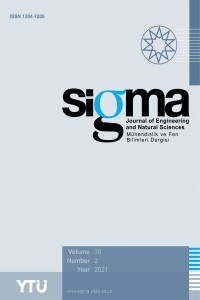EVALUATIONS ON THE ENERGY IDENTITY CERTIFICATE AND THE USABILITY OF CALCULATION METHOD OF BUILDING ENERGY PERFORMANCE (BEP)
___
- [1] Durmuş, G., and Önal, S. (2018) Assessment of Energy Performance of Buildings Constructed in Different Regions of Turkey According to European Specification. Politeknik Journal 21(3), 581-586.
- [2] Internet: T.C. Cumhurbaşkanlığı Mevzuat Bilgi Sistemi, Binalarda Enerji performans Yönetmeliği, URL: https://www.mevzuat.gov.tr/mevzuat?MevzuatNo=13594&MevzuatTur=7&MevzuatTertip=5, last accessed on 22.03.2020.
- [3] Akdogan, K. E., Ustaoglu, D., Akoglu, K., Fil, C., Tastan, T., and Harputlugil, G. U. (2016) Development of a Software Based System to Apply Turkish Building Energy Performance Directive. MATTER, International Journal of Science and Technology 2(1), 167-182
- [4] Islamoglu, A. K. K. (2017) Design Methods Affecting Energy Consumption in Residences and Examination of Application Examples with BEP-TR Method, Master Thesis, Institute of Engineering and Science, Fatih Sultan Mehmet Foundation University, Istanbul, Turkey.
- [5] Yaka, I.F., Önal, S., Koçer, A. and Güngör,A., (2016) Comparison of Different Provinces in Determining Energy Performance in Buildings. Global Engineering Studies Journal 3(2), 127-135.
- [6] Anbarcı, M., Giran, Ö. And Demir, İ. H., (2012) International Green Building Certification System and Building Energy Efficiency Implementation in Turkey. Engineering and Science 7, 368-383.
- [7] Önal, S., (2014) Evaluations on Energy Identity Certificates of Buildings. Journal of the European Union and Technology 1(3), 100-105.
- [8] Harputlugil G.U., Yilmazoglu Z. and Unlu G.; (2019), Assessing the reliability of Turkish building energy performance tool (BEPTR2) by case test, CLIMA 2019, REHVA Congress, 26-29 May 2019, Bucharest, Romania.
- [9] Aydın, Ö. and Canım, D. S., (2017) Evaluation of Usability and EKB Application of Energy Performance Calculation Method (BEP-TR-1) in Buildings. Architecture and Life 2(2), 265-277.
- [10] Halıcı, F., (2019) Kalorifer ve Havalandırma Tesisatı (Isı Yalıtımı ve Örnek Proje), Birsen Yayınevi, Istanbul, Turkey.
- [11] Internet: Bep Gov.Tr, BEP-TR Binalarda Enerji Verimliliği, URL: http://www.bep.gov.tr/BEPTRWEB/Default.aspx#.Xrw8_2gzZnI, last accessed on 10.11.2019.
- [12] Internet: BEP-TR Yazılım Programı 2. Versiyon Kullanım Kılavuzu, URL: https://webdosya.csb.gov.tr/db/meslekihizmetler/ustmenu/ustmenu1007.pdf, last accessed on 24.03.2020.
- [13] Urmamen, E., (2019) Energy Efficiency in Turkey and the World. Master Thesis, Graduate School of Natural and Applied Sciences, Atatürk University, Erzurum Turkey.
- ISSN: 1304-7191
- Yayın Aralığı: Yılda 4 Sayı
- Yayıncı: Yıldız Teknik Üniversitesi
Muhammet YURDAKUL, Fatih YILMAZ, Musa ARTAR
Yavuz Selim HATİPOĞLU, Oğuz Akın DÜZGÜN
Okan GÜNGÖR, Halil İbrahim YÜKSEK
Alper Erdem YILMAZ, Yeşim DEDE SAĞSÖZ, Merve SAKARYA, İbrahim CENGİZ
Kadir BILEN, Esra URMAMEN, Muhammed Taha TOPCU, Ismail SOLMAZ
Çağlar YÜKSEL, Abdulhadi KOŞATEPE
